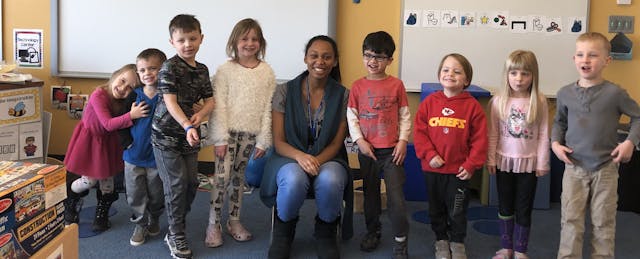OVERLAND PARK, Kan. — Dylin Coburn is a junior in high school, but he’s spent a surprising amount of time at a school that’s not his, observing an art class he’s not even taking. It’s not about making more art though—it’s practice. When he gets older, Dylin wants to teach, and thanks to a forward-thinking career readiness program in his district, he’s already gaining classroom experience, learning how classes are structured and designing an art workshop he hopes to one day implement at his own school, which currently does not have an art teacher.
“Art is something that I'm really passionate about,” he explains. “It helped me through a lot of things, and I kind of want to be able to help kids through art.”
Like Dylin, senior Jada Harper hopes to be a teacher too someday, focusing on early childhood special education. Next year she will head to Chicago’s DePaul University to study education, but with a significant leg up from her future classmates: She’s spent months embedded in a preschool classroom, observing and supporting the teacher, meaning she has a good idea of what to expect when she one day has a class of her own.
“I love it there,” she says. “The kids are high energy, so it's kind of hard to keep that energy and match their pace, especially when they're trying to climb all over me and they're tackling me, but it's super fun and I love those kids a lot.”
Where most future teachers don’t get into classrooms until the middle or end of college, Dylin and Jada are part of a unique teacher prep program at the Blue Valley Unified School District here in this heartland suburb of Kansas City. Some students in the program work on special projects related to areas of interest, such as Dylin’s art workshop. Others move through a more traditional slate of teacher prep, logging dozens of hours creating lesson plans and trying them out with students by the time they graduate high school.
The goal, program leaders say, is to give students a chance to explore careers in a hands-on way much earlier than usual.
“What we are doing is helping fast-forward kids so they're making some of those decisions that most adults make late in their college career, maybe even into their first career,” says Chad Ralston, who directs the careers program, Center for Advanced Professional Studies, or CAPS. “And to be honest, kids have to be able to understand why they're doing something. We've all asked, ‘Why do I have to learn this,’ right?”
For half the school day, students do regular coursework at their high school. The other half is spent in the career program they’ve chosen. In the mornings, Dylin and Jada take courses at their respective high schools. Some days after lunch, they spend time observing classes. Other days, they trek to CAPS, a modern three-story building flooded with natural light, built specifically to house the district’s career academies that range from engineering to healthcare to business entrepreneurship and, of course, teacher prep.

For students, it offers a chance to experiment with different careers in a genuine, hands-on way that’s still somewhat low-stakes. (Students can—and often do—move between programs, which are known here as “strands.”)
Like many college programs for high school students, CAPS is an opt-in program in which students take courses for college credit. But much of their time is spent preparing for their future careers, says Jennifer Collet, the program’s business development specialist, who connects community partners, like schools and local businesses, to the program.
CAPS began life here at Blue Valley, but has since expanded to more than three dozen districts across the country through a kind of franchise model that offers implementation and ongoing support. The goal of the CAPS program, particularly at Blue Valley, is to connect the local community with the workforce of tomorrow, explains Ralston. That’s especially important in the Midwest, he says, where declining industry has turned once-stable communities into economically disadvantaged areas.
The CAPS program itself is about a decade old, but the building is a year younger. For the first year, students were embedded full-time in a location that mirrored their profession. For the teacher prep program, that meant a local elementary school.
“When we were in the elementary school, we would do assemblies we did morning duty, lunch duty, everything,” explains Tammy Fry, the program director for CAPS’ teacher prep program. “When we came here, we lost some of that, but of course we gained the collaboration amongst the other strands.”
Students are encouraged to be collaborative with members of their own strands when they’re on-site, but they also work with students from other stands as well. Since CAPS pulls from the five high schools in the district, this gives students with different interests who might otherwise never meet the chance to work together. Through the years, Fry’s students have developed STEM lesson plans about oil spills and aerodynamics with CAPS students studying engineering and have turned to peers in the medical strand when learning how to teach concepts related to DNA.
To compensate for that lost sense of embedded community, Fry has her students head to elementary schools in the district most Monday afternoons to help with lunch duty and other tasks teachers are often responsible for. Typically, they spend up to three more days each week at their assigned school, filling voluminous notebooks with detailed observations. After their first semester at CAPS, when they pass certain certification requirements, many start teaching lessons of their own.
On Thursdays, they meet back at the center for lessons on pedagogy but also to debrief as a class, try out lesson plans and work with students in other strands.
In an effort to give students a taste of what adulthood and careers are actually like, CAPS gives its students a wide degree of latitude and freedom to complete their work, both on-site and in the field. The building has no bell schedule and students are free to move around as they wish.
“Students often say that the thing they like best about CAPS is that they’re treated like adults,” Collet says. “But when you really dig deep and ask why that is, it's that ability to learn autonomously—and a lot of that is to control their own space and time.”
According to CAPS, about 95 percent of the overall program’s graduates go to college after they graduate, although tracking them after they leave the district can be tricky. Based on National Student Clearinghouse data, CAPS says its graduates end up finishing college faster than other students.
For deeper insight, Fry recently conducted an informal survey through social media of more than three-dozen graduates of her teacher prep program. The majority of respondents were still in college—about 85 percent of them studying education or planning to teach.
Of the 40 percent who had already finished their undergraduate degrees, about half were working as full-time teachers, but Fry says many more shared that while they’re not actively teaching, they work in ancillary school positions or as substitute teachers.
“I was pleased to find out from the results that so many of our alumni have continued their teacher ed work at the university level, and it gave me a chance to look at the bigger picture and the scope of what we do,” Fry says. “I am so thrilled that taking part in our CAPS program helps to lead young adults to their true passions. I tell my students that it is just as important to discover what you don’t want to do as it is to find out what you do want to do.”
In the teacher prep program, exploring those passions comes from the teaching and observation duties students take on, but also from independent projects they’re encouraged to work on during their free time.
Dylin, the junior studying to become an art teacher, is hard at work on his art workshop proposal, which he eventually plans to present to his school’s leadership team. He’s also developing on a recurring evening event called an art mentor night for middle and high school students, which he hopes to bring to fruition next fall.
Simultaneously, he’s lending a hand to Jada, on a project she’s working on in collaboration with the nonprofit arm of a professional learning company, Indigo Education. The goal is to create lesson plans on building businesses for a high school in rural Southeastern Utah, near a Navajo reservation, where students don’t often have a set plan for life after high school.
“We're looking at finishing all of the lesson plans, having all the resources implemented and then for Indigo to present that to the teacher,” says Jada. “The long-term goal is to use that [lesson plan] year after year so it becomes sustainable.”
For now, both students say they’re even more committed to teaching than they were when they started at CAPS, and they’re grateful for the experience. Although working on the other side of the teacher’s desk presents its share of challenges as well. “I've learned students are tricky sometimes,” Dylin says. “They do not like you at points.”
Correction: An earlier version of this story misspelled the names of CAPS' business development specialist, Jennifer Collet, and CAPS director, Chad Ralston. The article has been updated.


